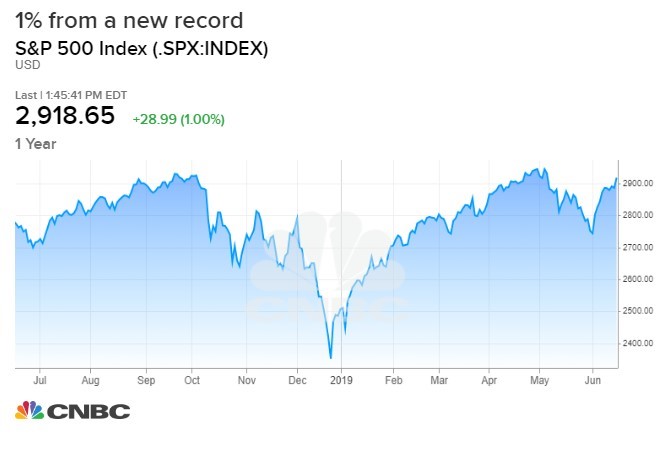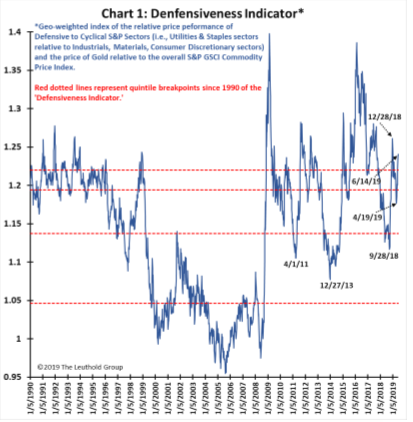Traders work on the floor at the New York Stock Exchange.
Brendan McDermid | Reuters
The S&P 500 is closing in on its all-time high, and is likely to sail past it, as long as the Fed continues to promise lower interest rates, and there is no irreparable divide between the U.S. and China on trade.
Stocks were rising Tuesday as markets anticipated a dovish Fed Wednesday, and as the European Central Bank’s outgoing president Mario Draghi laid out a path for the ECB to loosen its own already lax monetary policy. The market also gained a boost, after President Donald Trump said he had a good discussion with China President Xi Jinping, and the two would have an extended discussion at the G-20 meeting in late June.
The Fed began its two-day meeting Tuesday, and was widely expected by economists to lay the groundwork for a July interest rate cut with new forecasts on rates and the economy, and a more dovish post-meeting statement on Wednesday.
“I think the equities market will continue to grind higher, save [Fed Chair Jerome]Jay Powell and the Fed not expressing something that is in line…or reflecting the market’s anticipated dovishness,” said Rick Rieder, BlackRock’s global CIO of fixed income
Rieder is also lead portfolio manager for BlackRock’s Global Allocation Fund, the firm’s largest mutual fund.
“When the Fed first cuts rates, they tend to be faster. They tend to be more aggressive,” said Rieder. He said he expects to see a 50 basis point, or half percentage point rate cut in July and another rate cut in September.

The S&P 500 was up about 1%, at 2,916 in afternoon trading Tuesday, just about 1% from its all-time closing high of 2,945, reached April 30. Its all-time intraday high was 2,954 on May 1. The Dow, meanwhile, was up 1.2%, or 300 points at 26,418, about 1.5% from its closing high of 26,828.
“What’s the market response to the Fed? It may be happening today. We’re going to hit the all-time high. Whether we hit it today or next week, we think the [S&P 500] can hit 3,025 by the by the end of the year. That’s another 3 or 4%, and that puts us in the clear optimistic camp,” said Jonathan Golub, chief U.S. equity strategist at Credit Suisse. “The market is just ripping. We think it’s going to be smoother between now and the end of the year, and we think we’re front-running the move.”
Golub said for the past five or six years, he’s seen rough spots in the market as buying opportunities. “We’re not saying that now. We’re not saying the market’s going to fall apart, but we’re just saying lower rates and lower inflation are not the elixir everyone thinks they are,” said Golub.
He said as the market focus shifted to the Fed, trade has become less of a concern in the last couple weeks, and there is an expectation that there will be some sort of agreement.
“But if I was really optimistic central banks were going to to really drive this, I would be increasing my numbers…It’s not that I’m pessimistic, but a guy who has been the most bullish strategist. In the last five or six years, we were right on that,” said Golub. “I’m a little more balanced, in my view than we’ve been in a long time. For the past month, we’ve been highlighting decelerating data.”
Investors still negative
But James Paulsen, chief investment strategist at Leuthold Group , said the defensive positioning of investors, in such assets as bonds, gold, and in defensive stock sectors, like utilities is bullish for the market, in a contrarian way.
“I think we’re going to go to a high. I don’t know how soon. I really think the second half of the year stocks could do a lot better than most people think is possible,” said Paulsen. “All the focus is on the Fed and the trade wars, but the biggest thing in the room might be a cautious investment mind set. That might be a bigger positive than any of the other events.”
Earlier, Bank of America Merrill Lynch released its monthly fund managers’ survey, which showed fund managers viewed the U.S. Treasury market as the most crowded trade.
Paulsen also said the fact investors have already “hunkered down for the worst, means it could be difficult for the worst to occur,” based on positioning.
“In 2007, investors were aggressive in their approach and out over their skis, and when it didn’t work out, it created the big decline,” he said.
Paulsen has created a ‘defensive indicator,’ based on the relative performance of gold, bonds, and the performance of defensive stock sectors relative to cyclical-stock sectors. Currently, the indicator suggests defensiveness is greater than it has been about 90% of the time since 1990.
He said when defensiveness has been in the upper quintile, as it is now, the future six-month average annualized percent gain in the S&P 500 has averaged 18.63%, compared to only 7.55% the rest of the time.

He said skeptical investors are fighting the Fed, the Treasury and “bond vigilantes,” or the fixed income investors who have been driving interest rates lower in the Treasury market. Yields move opposite price.
Paulsen notes that the fiscal deficit as a percent of GDP has gained about a percentage point in the past year to 4.7%. “That’s stimulative. At the same time, the Fed is cutting interest rates and yields are down sharply. The 10-year yield was at 3.25 at its high and was at almost 2% today,” he said. The 10-year was at 2.05% in afternoon trading.
All of those factors make stocks look more appealing, he said.
WATCH: Art Hogan says there’s not enough evidence for rate cuts in June or July
 EU News Digest Latest News & Updates
EU News Digest Latest News & Updates



